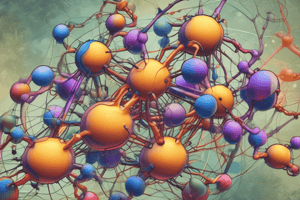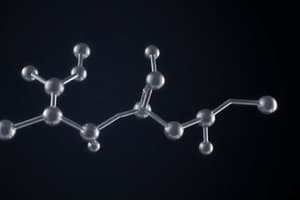Podcast
Questions and Answers
In Competitive Inhibition, the inhibitor and the substrate compete for binding to the ______ site
In Competitive Inhibition, the inhibitor and the substrate compete for binding to the ______ site
catalytic
In Noncompetitive Inhibition, the inhibitor binds to a site outside of the substrate site, preventing ______
In Noncompetitive Inhibition, the inhibitor binds to a site outside of the substrate site, preventing ______
catalysis
Irreversible inhibition can occur when the inhibitor reacts with and covalently changes the enzyme, killing its ______
Irreversible inhibition can occur when the inhibitor reacts with and covalently changes the enzyme, killing its ______
activity
Uncompetitive inhibitors only bind to the ES complex, affecting ______ but not substrate binding
Uncompetitive inhibitors only bind to the ES complex, affecting ______ but not substrate binding
Reversible modes of inhibition include competitive, noncompetitive, and ______ inhibition
Reversible modes of inhibition include competitive, noncompetitive, and ______ inhibition
Irreversible inhibitors, such as suicide substrates, react irreversibly with the reactive R-groups that mediate the enzyme ______
Irreversible inhibitors, such as suicide substrates, react irreversibly with the reactive R-groups that mediate the enzyme ______
In Uncompetitive Inhibition, the Vmax is lower but the apparent Km is also ______
In Uncompetitive Inhibition, the Vmax is lower but the apparent Km is also ______
Adding much more substrate in Competitive Inhibition can outcompete the inhibitor to achieve the same ______
Adding much more substrate in Competitive Inhibition can outcompete the inhibitor to achieve the same ______
The Uncompetitive Inhibitor will only bind to the ES complex, slowing the transition from ES to EP, resulting in a lower ______
The Uncompetitive Inhibitor will only bind to the ES complex, slowing the transition from ES to EP, resulting in a lower ______
Covalent modifications are reversible means of affecting an enzyme’s ______
Covalent modifications are reversible means of affecting an enzyme’s ______
Regulatory enzymes are targets of regulatory mechanisms; their allosteric regulation is indicated by ______ kinetics
Regulatory enzymes are targets of regulatory mechanisms; their allosteric regulation is indicated by ______ kinetics
DIPF (Di-IsoPropylFluorophosphate) is a potent neurotoxin developed in WWII as a chemical warfare agent. The Serine in the active site attacks the exposed __________ electrophile forming a very stable covalent Phospho-Serine bond.
DIPF (Di-IsoPropylFluorophosphate) is a potent neurotoxin developed in WWII as a chemical warfare agent. The Serine in the active site attacks the exposed __________ electrophile forming a very stable covalent Phospho-Serine bond.
The Transition State analogs bind so tightly that they are effectively __________ Inhibitors
The Transition State analogs bind so tightly that they are effectively __________ Inhibitors
Group-Specific Inhibitors are Irreversible Inhibitors that target specific groups in the catalytic site and form a covalent intermediate that kills the enzyme; e.g., Nerve Gas killing of __________
Group-Specific Inhibitors are Irreversible Inhibitors that target specific groups in the catalytic site and form a covalent intermediate that kills the enzyme; e.g., Nerve Gas killing of __________
Aspartate Transcarbamoylase and Glycogen Phosphorylase are good examples of regulatory enzymes that are regulated at multiple levels to yield finely-tuned biological ______
Aspartate Transcarbamoylase and Glycogen Phosphorylase are good examples of regulatory enzymes that are regulated at multiple levels to yield finely-tuned biological ______
Suicide Substrate Inhibitors are a special class of irreversible inhibitors that enter the catalytic site and partial catalysis creates an active intermediate that covalently kills the enzyme. These inhibitors are a type of __________ Inhibition.
Suicide Substrate Inhibitors are a special class of irreversible inhibitors that enter the catalytic site and partial catalysis creates an active intermediate that covalently kills the enzyme. These inhibitors are a type of __________ Inhibition.
Reversible Inhibition implies that the binding of the inhibitor to the enzyme is not permanent or possible to outcompete by addition of more substrate. There are multiple forms of Reversible Inhibition: Competitive Inhibition, Uncompetitive Inhibition, Mixed Inhibition, and __________ Inhibition.
Reversible Inhibition implies that the binding of the inhibitor to the enzyme is not permanent or possible to outcompete by addition of more substrate. There are multiple forms of Reversible Inhibition: Competitive Inhibition, Uncompetitive Inhibition, Mixed Inhibition, and __________ Inhibition.
In Competitive Inhibition, Substrate and Inhibitor compete for binding to the same site on the enzyme. In Uncompetitive Inhibition, the inhibitor will ONLY bind to the ES complex. In Mixed and Non-Competitive Inhibition, the inhibitor will bind to either E or ES; Noncompetitive is a special case of __________ Inhibition.
In Competitive Inhibition, Substrate and Inhibitor compete for binding to the same site on the enzyme. In Uncompetitive Inhibition, the inhibitor will ONLY bind to the ES complex. In Mixed and Non-Competitive Inhibition, the inhibitor will bind to either E or ES; Noncompetitive is a special case of __________ Inhibition.
Flashcards are hidden until you start studying




